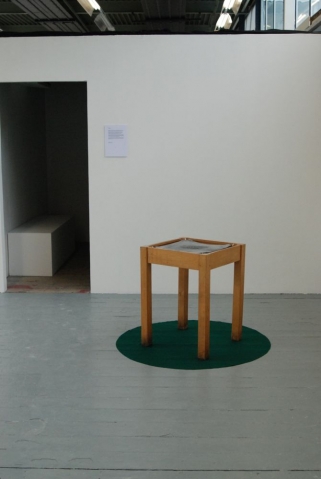I need to order the baize, cut it and fix it to the floor. Before that I need to shift some rubbish, paint the floors, do a black-out blind for my video space, scrape the floor some more for the video space, burn off my video properly, measure and attach a floating screen, and so on.
We blocked in a doorway this week, smoothed off the space. The person who used it last year has been very tidy so apart from the doorway there's only minor work to do.
I'm making more tables when I really should be finishing the ones I've got. A few have turned out to be the same height which looks a bit peculiar – if I'd have planned better I would've seen that coming, but one thing that's been pointed out is that I sometimes plan too much. Instead of doing. But if I'd followed my plans on this one then I would've made just one table. Swings and roundabouts. Tables.
I think I only have one more bit of filming to do and then my video is finished. I didn't really storyboard this domestic one so there's a few continuity errors that I've had to edit out, or re-film a certain section. It was all filmed out of order but I've managed so far. Stuff like picking up my cup of tea with the wrong hand, and in particular, I take the bin out and then leave the door open when I come back in.
It's hard to decide what to concentrate on – we all get an assistant during the show, so I can let them paint walls and stuff like that. I need a lockable box and a hanging wooden board for my video projection, so I'm thinking about those, but also convincing myself to leave it for the assistant. I've had problems in the past being too 'precious' about some of my pieces, and I ended up having a lot of work to do, so I'm conscious of that.
The tables are coming along okay – I had loads of ideas at the start and then settled on a very simple design that said more than a lot of the complicated ones.
It's a similar idea to the video, about moving around a certain space, what activates the space and the thought process, and also what deactivates it. I'm trying to tap into the viewer's visualisation of a game's theory. Where things go, how it works, and then placing things to interrupt this thought process. These 'interrupts' are largely based on tactile responses and an inherent knowledge of simple games. Dice are to be thrown, tables have things on them, you sit up to the table to play, usually opposite someone, the boards are usually square, a dice thrown on the floor is usually deemed void, out of play, green felt is a common playing surface…
All of these elements can be moved around and by altering them or placing them differently, I can 'upset' this intrinsic familiarity we all have and hopefully stimulate some sort of response.
I had a massive gap while I got folders together for assessment and concentrated on the videos, so I've only recently made this table. I had the materials and also had more ideas in the meantime, so I'm just making them all and seeing what works. I might have one piece, or a group of 5 or 6, but it's good to have a choice. See what works best in the space.
All footage for Phlebitis has essentially been scrapped, in favour of a completely new film, as yet untitled.
I have used the same method and some of the same techniques I developed in filming and editing the first set of footage. Phlebitis has become a largely technical exercise, and some issues has been raised regarding the suit. It is appropriate, but I understand the problems with it.
The editing techniques I'm using are based around numbers and ratios, and I've been able to flip between footage and get 2 of me on screen at once. By altering the number of frames given to each float sequence I can intensify one persona, and even make it move more slowly, which gives a really strong conflict on screen. However, while this is extremely interesting to me, it's not really translating through to the final film.
The new setting is domestic, there's no suits, and it's based around routine, but still carries through the original idea of disengagement, acting subconsciously. Moving without travelling?
As well as moving round Newcastle centre I used the project space in the sculpture studios, a long room for communal use. By jumping in this space, I was then able to manipulate my movement using different editing techniques. By changing the number of frames from 3 to 1, I made a much faster, frantic movement.
Jump cutting also allowed for further possibilities, as well as mixing footage from different jump sequences.
I am using iMovie 08, which has been really useful for its 'skimming' technology. I can browse the footage by moving the cursor over the timeline for the raw footage, which makes picking 3 frames from maybe 10 seconds of footage really easy.The major problem is the sheer number of bugs in this version – it is designed primarily for trimming footage and putting it on YouTube. Family footage, basic films – not for complex, 24 fps art videos.
At 3 frames per jump, 1 second of footage takes 8 shots. A 3 minute video therefore requires over 1,300 separate jumps. Using single frames increases this number and basically crashes iMovie.
When using 1 frame shots, moving them around is also revealing serious bugs. Instead of the shot going where I place it, it moves 2 shots to the left. Using the keyboard shortcuts puts it 1 shot to the right.
Making this video is difficult.



